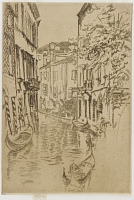Etchings Institutions search term: grolier club
Quiet Canal | ||
| Number: | 224 | |
| Date: | 1879/1880 | |
| Medium: | etching and drypoint | |
| Size: | 229 x 154 mm | |
| Signed: | no | |
| Inscribed: | no | |
| Set/Publication: | 'Second Venice Set', 1886 | |
| No. of States: | 4 | |
| Known impressions: | 35 | |
| Catalogues: | K.214; M.211; W.184 | |
| Impressions taken from this plate (35) | ||
STATE
Four states are known before cancellation.
State 1

There is no signature or inscription.
The composition is mostly complete; faint lines remain from earlier versions of the prow of the gondola with the seated man.
State 2

Some lines from earlier versions of the prow are removed; some shading and detail on the central house are removed or reduced, most notably affecting the upper central window and the hanging sheet or awning below it.
State 3

The upper prow of the gondola with the seated man is darkened, and the faint lines from earlier versions are mostly gone; short vertical lines are added to the ripples on the water in the centre foreground; there are specks of foul biting in the left foreground; a small patch of drypoint diagonal lines is added to the lower centre of the foliage at right; a group of fine, curving, diagonal scratches appear across the doorway at the extreme right.
Published in this and the next state by Messrs Dowdeswell and Thibaudeau with the Twenty-six Etchings (the 'Second Venice Set') in 1886.
State 4

The right side of the prow of the gondola with the seated man is shaded with diagonal drypoint lines, and there are vertical drypoint lines on the hull; very fine vertical lines are added to the water to left of the prow and around the seated man; a patch of vertical lines is added on the centre house, above the water line to right of the door.
During the course of printing, many of the lines added in this state and the previous one became worn and are very difficult to see on many impressions. Kennedy believed that drypoint lines in the foreground had been removed and included a fifth state in his catalogue. 7 However, the fine lines are visible under magnification on most impressions and are present on the copper plate. Therefore it is clear that Whistler did not intentionally remove them, and that there is just one fourth state, with lines of varying clarity. An impression with worn lines is illustrated below.
7: Kennedy 1910 (cat. no. 214 V).


